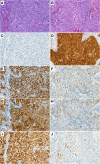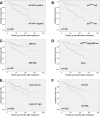Prognostic significance of cell cycle-associated proteins p16, pRB, cyclin D1 and p53 in resected oropharyngeal carcinoma
- PMID: 30189895
- PMCID: PMC6127938
- DOI: 10.1186/s40463-018-0298-3
Prognostic significance of cell cycle-associated proteins p16, pRB, cyclin D1 and p53 in resected oropharyngeal carcinoma
Abstract
Background: Human papillomavirus (HPV)-related oropharyngeal squamous cell carcinoma (OPSCC) has an improved outcome and may allow for treatment de-escalation. High-risk HPV (HR-HPV) infection is associated with deregulated expression of the cell cycle-associated proteins p16INK4, pRB, cyclin D1 and p53. The objective of this study was to assess cell cycle proteins as potential surrogate markers for HR-HPV DNA testing to identify OPSCC with favorable prognosis after resection.
Methods: Tissue microarray cores of 313 surgically treated OPSCC were stained for p16INK4a, pRB, cyclin D1 and p53 using immunohistochemistry. Protein expression was scored as high or low based on the proportion of positive carcinoma cells. Tumor samples were analysed for HR-HPV DNA with polymerase chain reaction-based testing. Associations between cell cycle protein expression and HR-HPV DNA status were evaluated by calculating sensitivity, specificity, predictive values, and diagnostic odds ratios (DOR). Kaplan-Meier and Cox regression analysis were applied to evaluate associations between cell cycle protein expression and patient outcome.
Results: High expression of p16INK4a, cyclin D1, pRB and p53 in tumor cells were observed in 51.8%, 51.4%, 41.9% and 33.5% of OPSCC, respectively. HR-HPV DNA positive were 158/313 (50.5%) tumor samples (HPV16: 147, HPV18: 1, HPV33: 5, HPV35: 2, HPV56: 2, and HPV59: 1). P16INK4a showed a higher DOR to predict HR-HPV DNA positivity than pRB, cyclin D1 and p53. Both the p16INK4a/pRB and the p16INK4a/pRB/cyclin D1/p53 signatures had lower DOR than p16INK4a alone. Improved 5-year overall and disease-specific survival were associated with HR-HPV DNA positivity, high p16INK4a, low pRB, low cyclin D1, and low p53 expression. Associations with improved outcome were also observed for the marker combinations high p16INK4a/positive HR-HPV DNA, high p16INK4a/low pRB and high p16INK4a/low pRB/low cyclin D1/low p53. In a multivariate analysis adjusted for age, smoking history, pT and pN category, high p16INK4a expression showed the lowest hazard ratio for death.
Conclusions: High p16INK4a expression is a reliable marker for survival prognostication in surgically treated OPSCC patients. Protein signatures including the pRB, cyclin D1 and p53 proteins do not further increase the prognostic performance of p16INK4a as a single marker.
Keywords: Cyclin D1; Human papillomavirus; Oropharyngeal squamous cell carcinoma; Prognosis; Retinoblastoma protein; p16; p53.
Conflict of interest statement
Ethics approval and consent to participate
The Ethics Committee Ostschweiz (EKOS), St. Gallen, Switzerland approved the study (EKSG 12/106/L/1B).
Consent for publication
Not applicable.
Competing interests
The authors declare that they have no completing interests.
Publisher’s Note
Springer Nature remains neutral with regard to jurisdictional claims in published maps and institutional affiliations.
Figures


Similar articles
-
Identification of oropharyngeal squamous cell carcinomas with active HPV16 involvement by immunohistochemical analysis of the retinoblastoma protein pathway.Int J Cancer. 2013 Sep 15;133(6):1389-99. doi: 10.1002/ijc.28142. Epub 2013 Mar 29. Int J Cancer. 2013. PMID: 23457055
-
p16 overexpression identifies oncogenic high-risk HPV infection in non-oropharyngeal squamous cell carcinoma of the head and neck.Head Neck. 2024 Oct;46(10):2569-2581. doi: 10.1002/hed.27764. Epub 2024 Apr 9. Head Neck. 2024. PMID: 38594829
-
Human papillomavirus in oropharyngeal squamous cell carcinomas in Korea: use of G1 cycle markers as new prognosticators.Head Neck. 2012 Oct;34(10):1408-17. doi: 10.1002/hed.21939. Epub 2011 Nov 2. Head Neck. 2012. PMID: 22052559
-
Diagnostic accuracy of p16INK4a immunohistochemistry in oropharyngeal squamous cell carcinomas: A systematic review and meta-analysis.Int J Cancer. 2017 Mar 1;140(5):1186-1198. doi: 10.1002/ijc.30516. Epub 2016 Dec 2. Int J Cancer. 2017. PMID: 27859245
-
From HPV-positive towards HPV-driven oropharyngeal squamous cell carcinomas.Cancer Treat Rev. 2016 Jan;42:24-9. doi: 10.1016/j.ctrv.2015.10.009. Epub 2015 Oct 31. Cancer Treat Rev. 2016. PMID: 26547133 Review.
Cited by
-
Analysis of HPV-Positive and HPV-Negative Head and Neck Squamous Cell Carcinomas and Paired Normal Mucosae Reveals Cyclin D1 Deregulation and Compensatory Effect of Cyclin D2.Cancers (Basel). 2020 Mar 26;12(4):792. doi: 10.3390/cancers12040792. Cancers (Basel). 2020. PMID: 32224897 Free PMC article.
-
p16 and p53 can Serve as Prognostic Markers for Head and Neck Squamous Cell Carcinoma.Int Dent J. 2024 Jun;74(3):543-552. doi: 10.1016/j.identj.2023.11.007. Epub 2023 Dec 16. Int Dent J. 2024. PMID: 38105167 Free PMC article.
-
Tumor microenvironment and immune evasion in head and neck squamous cell carcinoma.Int J Oral Sci. 2021 Aug 2;13(1):24. doi: 10.1038/s41368-021-00131-7. Int J Oral Sci. 2021. PMID: 34341329 Free PMC article. Review.
-
p53 and PTEN expression evaluation with molecular evident recent criteria in laryngeal carcinoma.Medicine (Baltimore). 2023 May 12;102(19):e33676. doi: 10.1097/MD.0000000000033676. Medicine (Baltimore). 2023. PMID: 37171328 Free PMC article.
-
mTOR Signalling in Head and Neck Cancer: Heads Up.Cells. 2019 Apr 9;8(4):333. doi: 10.3390/cells8040333. Cells. 2019. PMID: 30970654 Free PMC article. Review.
References
-
- O'Sullivan B, et al. Development and validation of a staging system for HPV-related oropharyngeal cancer by the international collaboration on oropharyngeal cancer network for staging (ICON-S): a multicentre cohort study. Lancet Oncol. 2016;17(4):440–451. doi: 10.1016/S1470-2045(15)00560-4. - DOI - PubMed
MeSH terms
Substances
Grants and funding
LinkOut - more resources
Full Text Sources
Other Literature Sources
Research Materials
Miscellaneous

